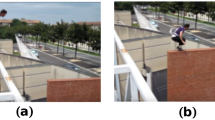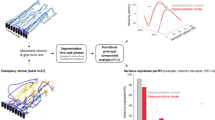Abstract
There are observations indicating that the central nervous system (CNS) decomposes a movement into several successive sub-movements as an effective strategy to control the motor task. In this study, we propose an algorithm in which, Arm Reaching Movement (ARM) in 3D space is decomposed into several successive phases using zero joint angle jerk features of the arm kinematic data. The presented decomposition algorithm for 3D motions is, in fact, an improved and generalized version of the decomposition method proposed earlier by Emadi and Bahrami in 2012 for 2D movements. They assumed that the motion is coordinated by minimum jerk characteristics in joint angles space in each phase. However, at the first glance, it seems that in 3D ARM joint angles are not coordinated based on the minimum jerk features. Therefore, we defined a resultant variable in the joint space and showed that one can use its jerk properties together with those of the elbow joint in movement decomposition. We showed that phase borders determined with the proposed algorithm in 3D ARM, are defined with jerk characteristics of ARM’s performance variable. We observed the same results in the Sit-to-Stand (STS) movement, too. Thus, based on our results, we suggested that any 3D motion can be decomposed into several phases, such that in each phase a set of principal patterns (PPs) extracted by Principal Component Analysis (PCA) method are linearly recruited to regenerate angle trajectories of each joint. Our results also suggest that the CNS, as the primary policy, may simplify the control of the ARMs by reducing the dimension of the control space. This dimension reduction might be accomplished by decomposing the movement into successive phases in which the movement satisfies the minimum joint angle jerk constraint. Then, in each phase, a set of PPs are recruited in the joint space to regenerate angle trajectory of each joint. Then, the dimension of the control space will be the number of the recruitment coefficients.














Similar content being viewed by others
References
Alessandro, C., Carbajal, J. P., & D’Avella, A. (2014). A computational analysis of motor synergies by dynamic response decomposition. Frontiers in Computational Neuroscience, 7(191), 1–20. https://doi.org/10.3389/fncom.2013.00191.
Bahrami, F., Moraes, R., & Patla, A. (2003). Control pattern of a combined task. In Proceedings of the ISPGR, Sydney, Australia.
Balasubramanian, S., Melendez-Calderon, A., Roby-Brami, A., & Burdet, E. (2015). On the analysis of movement smoothness. Journal of Neuroengineering and Rehabilitation, 12(1), 1–11. https://doi.org/10.1186/s12984-015-0090-9.
Biess, A., Liebermann, D. G., & Flash, T. (2007). A computational model for redundant human three-dimensional pointing movements: integration of independent spatial and temporal motor plans simplifies movement dynamics. Journal of Neuroscience, 27(48), 13045–13064. https://doi.org/10.1523/JNEUROSCI.4334-06.2007.
Bizzi, E. (2007). Motor primitives and rehabilitation. Virtual Rehabilitation (pp. 20–22). Venice, Italy. https://doi.org/10.1109/ICVR.2007.4362123.
Bizzi, E., Mussa-Ivaldi, F. A., & Giszter, S. (1991). Computations underlying the production of movement: a biological persectiv. Science, 253(July), 287–291.
Bizzi, E., D’Avella, A., Saltiel, P., & Tresch, M. (2002). Modular organization of spinal motor systems. The Neuroscientist, 8(5), 437–442. https://doi.org/10.1177/107385802236969.
Burdet, E., & Milner, T. E. (1998). Quantization of human motions and learning of accurate movements. Biological Cybernetics, 78, 307–318. https://doi.org/10.1007/s004220050435.
Chiovetto, E., Berret, B., & Pozzo, T. (2010). Tri-dimensional and triphasic muscle organization of whole-body pointing movements. Neuroscience, 170(4), 1223–1238. https://doi.org/10.1016/j.neuroscience.2010.07.006.
Emadi, M., & Bahrami, F. (2012). COMAP : a new computational interpretation of human movement planning level based on coordinated minimum angle jerk policies and six universal movement elements. Human Movement Science, 31, 1037–1055.
Eriksson, A. (2008). Optimization in target movement simulations. Computer Methods in Applied Mechanics and Engineering, 197, 4207–4215.
Flash, T., & Hogan, N. (1985). The coordination of arm movements: an experimentally confirmed mathematical model. The Journal of Neuroscience, 5(7), 1688–1703. https://doi.org/10.1523/JNEUROSCI.05-07-01688.1985.
Friedman, J., & Flash, T. (2009). Trajectory of the index finger during grasping. Experimental Brain Research, 196(4), 497–509. https://doi.org/10.1007/s00221-009-1878-2.
Galli, M., Cimolin, V., Crivellini, M., & Campanini, I. (2008). Quantitative analysis of sit to stand movement: experimental set-up definition and application to healthy and hemiplegic adults. Gait & Posture, 28(1), 80–85.
Ghahramani, Z., & Wolpert, D. M. (1997). Modular decomposition in visuomotor learning. Nature, 386(6623), 392–395. https://doi.org/10.1038/386392a0.
Hoffmann, E. R., & Sheikh, I. H. (2017). Targeted paced and unpaced movements in the transverse and sagittal planes. Journal of Motor Behavior, 49(2), 200–217. https://doi.org/10.1080/00222895.2016.1169985.
Hogan, N., & Sternad, D. (2012). Dynamic primitives of motor behavior. Biological Cybernetics, 106, 727–739. https://doi.org/10.1007/s00422-012-0527-1.Dynamic.
Hogan, N., & Sternad, D. (2013). Dynamic primitives in the control of locomotion. Frontiers in Computational Neuroscience, 7(June), 71. https://doi.org/10.3389/fncom.2013.00071.
Kobayashi, Y., Kawano, K., Takemura, A., Inoue, Y., Kitama, T., Gomi, H., & Kawato, M. (1998). Temporal firing patterns of Purkinje cells in the cerebellar ventral paraflocculus during ocular following responses in monkeys II. Complex spikes. Journal of Neurophysiology, 80(2), 832–848.
Latash, M. L. (2016). Neuroscience and biobehavioral reviews towards physics of neural processes and behavior. Neuroscience and Biobehavioral Reviews, 69, 136–146. https://doi.org/10.1016/j.neubiorev.2016.08.005.
Momtahan, M., Dehghani, S., Bahrami, F., Moradi, H., & Najafi, F. (2015). Design of a planar parallel robot to investigate human arm point to point reaching movement. In 22nd Iranian Conference on Biomedical Engineering (pp. 227–232).
Nakano, E., Imamizu, H., Osu, R., Uno, Y., Gomi, H., Yoshioka, T., & Kawato, M. (1999). Quantitative examinations of internal representations for arm trajectory planning: minimum commanded torque change model. Journal of Neurophysiology, 81(5), 2140–2155.
Nishii, J., & Taniai, Y. (2009). Evaluation of trajectory planning models for arm-reaching movements based on energy cost. Neural Computation, 21(9), 2634–2647. https://doi.org/10.1162/neco.2009.06-08-798.
Nori, F., & Frezza, R. (2005). A control theory approach to the analysis and synthesis of the experimentally observed motion primitives. Biological Cybernetics, 93(5), 323–342. https://doi.org/10.1007/s00422-005-0008-x.
Overduin, S. A., D’Avella, A., Roh, J., & Bizzi, E. (2008). Modulation of muscle synergy recruitment in primate grasping. The Journal of Neuroscience, 28(4), 880–892. https://doi.org/10.1523/JNEUROSCI.2869-07.2008.
Polyakov, F., Stark, E., Drori, R., Abeles, M., & Flash, T. (2009). Parabolic movement primitives and cortical states : Merging optimality with geometric invariance, 159–184. https://doi.org/10.1007/s00422-008-0287-0
Riley, P. O., Schenkman, M. L., Mann, R. W., & Hodge, W. A. (1991). Mechanics of a constrained chair-rise. Journal of Biomechanics, 24(1), 77–85.
Sadeghi, M., Emadi, M., Bahrami, F., & Parnianpour, M. (2013). Trajectory of human movement during sit to stand: a new modeling approach based on movement decomposition and multi- phase cost function. Experimental Brain Research, 229(2), 221–234. https://doi.org/10.1007/s00221-013-3606-1.
Scholz, J. P., & Schöner, G. (1999). The uncontrolled manifold concept : identifying control variables for a functional task. Experimental Brain Research, 126, 289–306.
Spong, M. W., Hutchinson, S., & Vidyasagar, M. (2006). Robot modeling and control (Vol. 141). John Wiley & Sons, Inc. New. https://doi.org/10.1109/TAC.2006.890316.
Todorov, E., & Jordan, M. I. (2002). Optimal feedback control as a theory of motor coordination. Nature Neuroscience, 5(11), 30–34. https://doi.org/10.1038/nn963.
Uno, Y., Kawato, M., & Suzuki, R. (1989). Formation and control of optimal trajectory in human multijoint arm movement. minimum torque-change model. Biological Cybernetics, 61(2), 89–101.
Acknowledgments
This work is a part of project #816 which is supported by the “Cognitive Sciences and Technologies Council” of Iran.
Author information
Authors and Affiliations
Corresponding author
Additional information
Publisher’s note
Springer Nature remains neutral with regard to jurisdictional claims in published maps and institutional affiliations.
Electronic supplementary material
ESM 1
(RAR 20 kb)
Rights and permissions
About this article
Cite this article
Dehghani, S., Bahrami, F. 3D human arm reaching movement planning with principal patterns in successive phases. J Comput Neurosci 48, 265–280 (2020). https://doi.org/10.1007/s10827-020-00749-2
Published:
Issue Date:
DOI: https://doi.org/10.1007/s10827-020-00749-2




